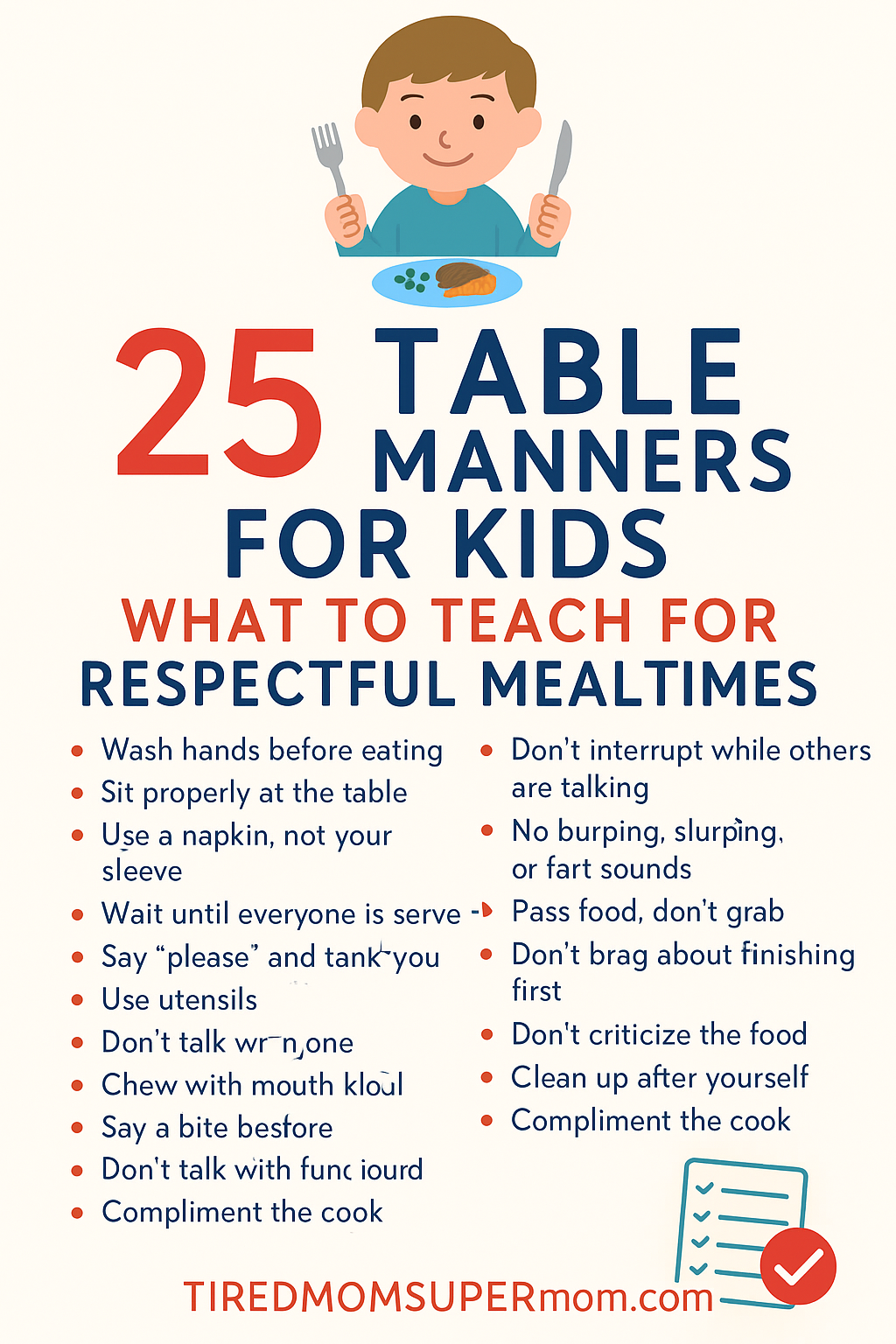25 Essential Table Manners for Kids to Inspire Respectful Mealtimes
Is your family dinner table feeling more like a food fight zone than a peaceful bonding moment? You’re not alone, mama. Teaching table manners for kids can feel like a never-ending process—but trust me, it’s one of the best life lessons you can give them. Not only does it create smoother mealtimes at home, but it also sets your child up to be polite and confident in social settings.
Let’s walk through a list of table manners that are age-appropriate, practical, and actually doable—no fancy etiquette school required.
Heads up: This post may include affiliate links. As an Amazon Associate, I earn from qualifying purchases—at no extra cost to you. Full privacy policy and disclosure here.

Why Table Manners for Kids Matter
Before we jump into the “how,” let’s talk about the “why.” Teaching table manners for kids isn’t just about appearances—it’s about:
- Respecting others at the table
- Practicing patience and gratitude
- Building confidence for social situations
- Reducing power struggles at mealtimes
Plus, consistent mealtime expectations help kids feel more secure, which is a core principle of gentle parenting.
25 Essential Table Manners for Kids (With Real-Life Tips)
Here are some of the most important table manners for kids—along with fun, realistic ways to teach them.
1. Wash Hands Before Eating
Make it a non-negotiable habit. Create a handwashing song or set a kitchen timer to keep it fun.
2. Sit Properly at the Table
Teach them to sit with their bottoms on the chair and feet down (or on a footrest for younger kids).
👉 Try this adjustable footrest for little ones who can’t reach the floor.
3. Use a Napkin, Not Your Sleeve
Have a fun cloth napkin just for them—bonus points if it features their favorite character.
4. Wait Until Everyone Is Served
Teach patience by playing “I Spy” or chatting about your day while waiting.
5. Say “Please” and “Thank You”
Use positive reinforcement phrases when they use polite language at the table.
6. Use Utensils (Not Hands)
Practice with fun training tools like this fork and spoon set for toddlers.
7. Don’t Interrupt While Others Are Talking
Encourage the “pass the salt, not the spotlight” rule—kids learn by modeling your behavior.
8. Chew With Mouth Closed
Use mirrors or roleplay to show the difference in manners. Make it silly!
9. Don’t Talk With a Full Mouth
This one’s non-negotiable for hygiene and etiquette.
10. No Burping, Slurping, or Fart Sounds
Normalize excusing yourself if an accident happens—etiquette doesn’t need to be shame-based.
11. Ask Before Leaving the Table
Teach them to say “May I be excused?”—it’s polite and gives them a sense of independence.
12. No Toys or Tablets at the Table
Make mealtime screen-free and use printable placemats or conversation cards instead.
Try these kids’ table topic cards to make it engaging.
13. Don’t Reach Across Plates
Practice “pass it, please” and encourage eye contact during the request.
14. Use Inside Voices
Keep volume down for a calmer, more enjoyable meal experience.
15. Don’t Criticize the Food
If they don’t like something, “No thank you” is enough. Teach this using positive parenting strategies.
16. Try a Bite Before Saying No
Use “try one bite” or “explorer bite” rules to reduce picky eating pressure.
17. Don’t Play With Food
Make food fun without turning it into a toy. Use plates with sections to keep things neat.
18. Clean Up After Yourself
Have kids bring their own dishes to the sink. Even toddlers can help with the right-sized dishware.
19. Stay Seated Until Done
Avoid the up-and-down chaos by using timers or playing calm background music to encourage stillness.
20. Compliment the Cook
Even if it’s boxed mac and cheese, a compliment builds gratitude and connection.
21. Pass Food, Don’t Grab
Set family-style meals to practice serving others.
22. Keep Hands to Yourself
No poking siblings with carrots, please.
23. Don’t Brag About Finishing First
Turn it into a lesson about being mindful and kind.
24. Help Set the Table
Involve them in prepping the meal space—it increases responsibility and connection.
25. Thank the Person Who Made the Meal
Always end with gratitude. It sets the tone for future social habits.
Positive Parenting + Table Manners Go Hand in Hand
If you’re trying to teach table manners without yelling or bribing—good news, you don’t have to! Gentle guidance and modeling are more effective long-term.
- Try using positive phrases instead of “no”
- Show appreciation using words of affirmation
- If they get discouraged, lean on “I can’t do it” mindset tips
Teaching manners is a marathon, not a sprint. You’ve got this, mama.
FAQ: Table Manners for Kids
What age should I start teaching table manners?
You can start as early as 2 years old. Begin with basics like sitting still and using a napkin, and gradually build up as they grow.
What are the most important table manners for toddlers?
Focus on just a few: sitting during meals, no throwing food, using a spoon, and saying “please” and “thank you.” Use fun utensils made for toddlers to make it easier.
How do I correct bad manners without shaming?
Use redirection—try this article on positive parenting redirection techniques for helpful scripts.
Are rewards or charts helpful for teaching manners?
Yes—just keep it intrinsic. Use a meal manners sticker chart to track progress with younger kids.
What if my child refuses to follow any table rules?
Stay consistent and patient. Reinforce small wins and revisit your approach using the 5 Pillars of Positive Parenting.
Helpful Resources for You
- 10 Table Manners to Teach Your Kids — from Parents Magazine
- Table Manners Etiquette for Kids — Britannica Kids
- Emily Post’s Table Manners for Kids — classic resource for older children
Conclusion
Teaching table manners for kids is more than just etiquette—it’s about raising kind, respectful humans who know how to show appreciation and handle social situations with confidence.
And the best part? It’s totally doable with the right mix of patience, playful teaching tools, and encouragement.
💡 Ready for Peaceful Mealtimes (and Mornings… and Bedtime Too)?
If you’re tired of repeating yourself 37 times before your child picks up a fork, you’re not alone. The Positive Parenting Solutions course changed the game for our family—and it can for yours too. 🙌
🌟 Get expert tools to teach manners, cooperation, and respect—without yelling or nagging.
👉 Click here to join Positive Parenting Solutions and start your parenting reset today.
📌 Don’t Forget to Pin This!
Save this post for later so you can come back to the full list and grab the printable manners chart!

💬 Let’s Chat!
What’s one table manner you’re working on with your kids right now? Drop a comment below—I’d love to hear what’s working (or what’s wild) at your dinner table!
